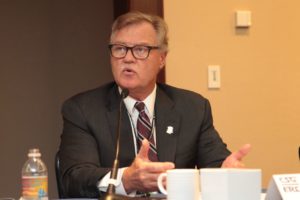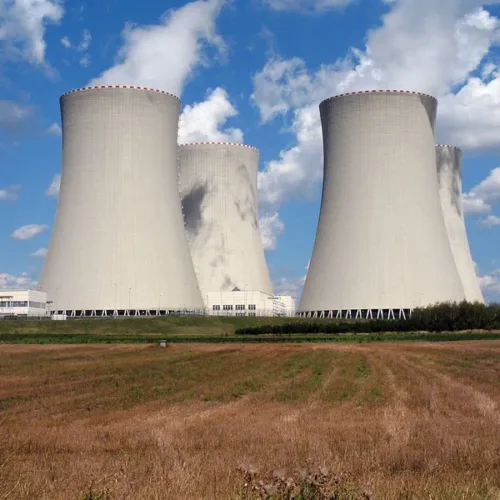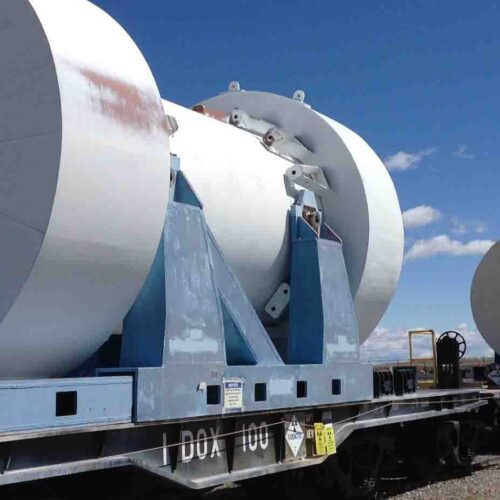Forging a Regional Energy Strategy amid a Marketplace in Transition
This article appeared in the 2017-18 edition of CSG East’s Perspectives Magazine.

The Millstone Nuclear Power Station in Waterford, Connecticut. Credit: Nuclear Regulatory Commission.
One afternoon during the CSG/ERC 2017 Annual Meeting, more than a dozen state and provincial officials stood before a simulated nuclear reactor at the Millstone Power Station, where an employee explained the fission process that provides about half of Connecticut’s power. The group had been invited to tour the plant, and the discussion quickly turned to a question looming in many policymakers’ minds: What would happen if the plant shut down?
Millstone’s owner, Dominion Energy, had not announced plans to close, but earlier in the summer, the company said that it would “continue assessing” its investments in Connecticut, after House lawmakers failed to pass a bill aimed at ensuring the plant would not retire before its license expired. Millstone and other reactors nationwide have been struggling to compete amid weak electricity prices.
“If Millstone closes today, where is Connecticut? And how do we move forward with our climate goals?” asked Connecticut State Senator Paul Formica during a panel discussion prior to the Millstone tour. Formica was a chief sponsor of the Millstone bill, and he emphasized the plant’s contribution to jobs and local industry. Millstone employs 1,500 people and pumps some $1.5 billion annually into the state economy. It also provides nearly all of Connecticut’s carbon-free power.
The discussion and tour were among a series of meetings sponsored by the CSG/ERC Energy and Environment Committee to assist members from around the region working to achieve a variety of energy goals, amid a marketplace that is in transition.
Over the last decade, the fuel mix has changed dramatically in much of the Northeast, thanks to abundant supplies of cheap natural gas from the Marcellus Shale, which has displaced higher-priced coal generation. During that period, nuclear power’s share of the energy supply remained fairly constant, at roughly one-third, but continued low natural gas prices are a key reason for a spate of recently announced plant closures in Vermont, Massachusetts, New Jersey, and Pennsylvania.

Connecticut State Senator Paul Formica
Connecticut is among several states that have explored policies to improve revenues to preserve the benefits that flow from nuclear power. In New York, regulators in 2016 adopted rules to provide subsidies to help three upstate nuclear plants that were considering closing because of stagnant energy demand and fierce competition from rock-bottom natural gas prices in interstate energy markets. Officials said the social and economic benefits of New York’s program — including fewer greenhouse gas emissions, lower prices for electricity, and jobs in the power-generation industry — would outweigh the cost to ratepayers, which they estimated would total less than two dollars a month.
Independent analyses prepared for Connecticut and New York officials have shown that if reactors were to close prematurely, much of the replacement power would come from natural gas because it would be impossible to ramp up enough wind and solar generation to offset the electricity, at least in the near term. That would lead to an increase in emissions of carbon and other pollutants, making it challenging to meet the states’ climate objectives. Both states have pledged to reduce their carbon emissions 80 percent below 1990 levels by 2050.
Connecticut’s bill would have allowed Millstone to compete in a state renewable energy procurement program, as a way to lock in long-term power prices for a portion of its output. It also would have called for an escalation of clean-energy development, requiring that by 2040, the state obtain 40 percent of its power from renewables, double the 2020 goal.
“We talked about nuclear being a bridge to a renewable future, and that’s what it has to be,” said Formica, who is Senate chair of the Connecticut Energy and Technology Committee.
A Regional Challenge
The discussion around the future of nuclear power is raising questions about how energy is priced in this country. Policymakers said that part of the challenge is a wholesale marketplace that doesn’t take into account the costs to the environment and public health associated with fossil fuel generation.

Connecticut State Representative Lonnie Reed
“Gas plants are ISO New England’s backup plan, since air quality is not their mandate; reliability and capacity are,” said Connecticut State Representative Lonnie Reed, referring to the nonprofit entity that oversees the region’s wholesale electricity markets. Reed is House chair of the Connecticut Energy and Technology Committee.
In current wholesale energy markets in the Northeast, customers pay for two key aspects of electricity generation and supply: energy, and capacity — meaning, they pay for the availability of generating capacity, which ensures that enough electricity will be at hand to meet demand on any given day. Dan Esty, Hillhouse professor of environmental law and policy at Yale University, suggested there should be a third element included in wholesale markets, which he calls attributes. “We should make people pay for the kind of electricity [they use] and how clean it is,” he said during the meeting.
Esty, a former commissioner in the Connecticut Department of Energy and Environmental Protection, reminded state policymakers that they wield significant power to control their energy future. He urged states to work collaboratively and create “new models of public engagement, policies, and incentives” to speed the adoption of cleaner energy sources and drive down the cost of emission-free power below those of energy that pollutes.
States have been exploring a variety of approaches to accelerate the shift to cleaner forms of energy, particularly in the absence of a federal policy.
New York has called for utilities to get half of their power from renewable sources by 2030, and Governor Andrew Cuomo has prioritized investments in renewables as part of his administration’s energy-system overhaul, known as Reforming the Energy Vision, or REV, launched in 2014. In addition, more than half a dozen transmission lines have been proposed to send lower-cost Canadian hydropower to New England and New York state.
In Massachusetts, where the 680-megawatt Pilgrim Nuclear Power Station is set to shut down in two years’ time, officials are hoping to dramatically increase imports of Canadian hydroelectric power and take advantage of the nascent offshore wind industry here.
Legislation signed by Governor Charlie Baker in 2016 requires utilities to procure 1.2 gigawatts of power from hydroelectricity or other renewable sources and 1.6 gigawatts from offshore wind in a little over 10 years, enough to power half a million homes. Ocean-based wind is still in its infancy in the United States, but several utility-scale wind farms have been proposed along the Eastern Seaboard, which is considered to have some of the best conditions in the world for the technology. Other states, including New York and Maryland, are aggressively promoting the sector (see sidebar).
Those developments are promising, but it will be several years before a utility-scale offshore wind farm begins sending power into the grid. Meanwhile, those who favor policies to keep nuclear plants in operation observe that concerns about rising emissions in the Northeast aren’t hypothetical. In 2015, the year after the Vermont Yankee nuclear plant closed, the region saw emissions rise for the first time in five years, the Boston Globe reported.
Many of those engaging in the policy debate over the future of the region’s nuclear fleet emphasize that it is a question of priorities and choosing from an imperfect set of options. There are safety issues associated with nuclear power and costs surrounding the storage of nuclear waste, which is being held in pools and dry casks on the site of the nation’s 99 commercial reactors, given the lack of a national long-term repository for spent fuel.
Others have argued that given the short window of time available to address climate change in order to avoid devastating global impacts, nuclear power must play a critical role.
Representative Reed said it should be possible to include nuclear power in a strategy to help renewables thrive. “We need a realistic transitional plan,” she said. “This requires thinking outside the usual rigid silos that seem to accompany energy industry planning.”





